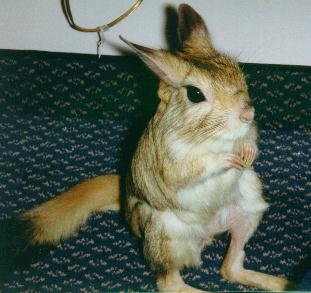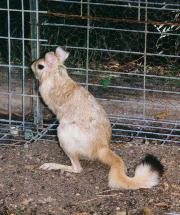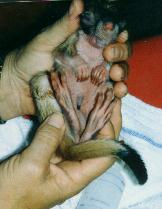Springhare
(Springhaas)
Springhares look like 8 pound jerboas.
I was tickled when I saw my first Springhaas in the flesh. Also called Springhare,
these 8 lb. animals are not hares at all but more in appearance like a Jerboa
on steroids. They are found in Zaire, Kenya and South Africa in dry, desert
or semi-arid areas. They are kangaroo-like as far as arms, legs and locomotion
go, but there the similarity ends. These adorable animals are not marsupials,
but in the Order Rodentia and are the only member of the Family Pedetidae. In
a 'class' by themselves, if you ever get close to one you will definately want
to study their many unusual physical characteristics. They have rich glossy
golden/reddish coats with fairly long hair that lays flat on their body. Some
are coated with soft buff or tan fur. There are some black and white hairs mixed
throughout the upper coat. Their amazingly strong tail is not prehensile, but
is 15 to 18 inches long and colored the same as their back, except the final
third which is solid black. The springhaas sometimes uses the tail as a balance
and brace when sitting. Their front legs are small, each equipped with a small
hand and five very long, curved claws. Their powerful back legs have large feet
each with four long toes ending in a tiny wide hoof-like nail. One of the rear
toes is much larger than the others. Their front and rear legs are highly specialized
with the front adapted for rapid and efficient digging and the rear for hopping,
jumping and leaping. Their ears are upright and translucent with only a smattering
of scattered hairs. Depressed or sick animals are easy to spot, because their
ears fall and the animal LOOKS terribly depressed. Their undersides are cream-colored.
In proportion to their head/body size, they have the most gorgeous, large, dark
brown eyes I have ever seen on an animal. The skull is large in proportion to
the body. Their nose is at the end of their muzzle like a 'normal' animal, but
their mouth is way underneath, 1/2 way to their neck. They remind me of a crab
on the beach when they make the feeding motions with their front feet, gathering
food and bringing it up to that mouth that looks like it is totally out of place.
Their dentition is i1/1, c0/0, p1/1, m3/3 x 2 for a total of 20 teeth.
The actual taxonomic classification is: Order: Rodentia Family: Pedetidae Genus:
Pedetes Species: Capensis
Springhaas mate at any time of the year and have a gestation about 78-82 days.
Normally only one young (and occasionally two) is born and it nurses for about
7 weeks. Most females rebreed during the lactation and have 3 to 4 litters per
year. Babies are born with teeth, fully furred with their eyes closed (which
open in 3-5 days) and ears open. They often eat solid food within a few days
of birth.
They are terrestrial and well adapted for digging. They are a favorite and important
food of the native people of South Africa. They dig burrows and tunnels and
rest in them during the day. In the wild, they are nocturnal in habit foraging
for bulbs, roots, grains and occasional grasses and insects. While they are
foraging, they move about on all fours, however, rapid movement is gained by
leaps and hops. They are able to move 10-25 feet in a single horizontal leap.
Although they are seen foraging together in the wild, they do not form an organized
social unit. They can live up to 15 years in captivity.
Springhares can be kept in
a simple corral but can dig like a backhoe so the bottom must be solid.
In a captive environment, I would suggest
a floor of clay, covered with wire mesh and 6-12 inches of clean sand. They
are avid diggers and can jump very high. Their pen should be constructed of
no more than 2 x 4 inch mesh (smaller if you have young animals )and have a
top. If the sides are 8 feet high and there is nothing to scare the animals
(such as dogs running loose) a top may not be necessary. We make tunnels with
two rows of baled grass hay, stacking a third row across the other two rows
to form the roof of the tunnel.
We have never found evidence of them drinking water although we offer them fresh
water every day in a stainless steel bowl. Our pen is clay and dirt and we have
never found evidence of any urination and suspect they internally recycle their
urine Moist foods in the form of the tubers listed below are critical.
Springhare are easy to feed. They do not fight over food, so a community dish
works fine. We currently use use two feed dishes in the group.
Bowl one, (fed free choice) contains: 1 part each: rodent chow and/or cattle
cubes with NO urea; mixed grains such as chicken scratch, corn, wheat, etc.;
sunflower seeds; rabbit chow.
Bowl two, fed in the late afternoon contains cut up: White potatoes, carrots,
yams, occasional apples and bananas in small quantities. They normally do not
prefer these sweet fruits.
Free Choice grass hay and non-toxic branches (willow, birch, etc.) are provided
at all times.
Purina Lagomorph diet can also be used for these animals in conjunction with
fresh fruits and vegetables and rodent chow. Because these animals are browsers
in the wild, you can also use Purina MazuriO Browser diets to maintain the high
level of crude fiber and low level of fermentable starches which is similar
to their natural diet.
We hesitate to list quantities because individuals vary according to size, sex,
maturity, activity level, stage of pregnancy or lactation. Use this only as
a guide, and monitor the animals weight and appetite. If the animal is gaining
too much weight, reduce the portion of food across the board, not one or two
items. Pregnant or nursing mothers will need a larger portion, sometimes 2-3
times the normal diet for that individual.
In addition to the normal diet, all rodents MUST have something non-toxic to
chew on such as willow or birch branches. Check with your county extension agent
or poison control center if you wish to feed branches from trees you do not
know are absolutely safe. If they do not have chewies, their teeth will not
wear down properly and can grow extremely long causing injury to the roof of
their mouth and other mouth parts.
These gentle animals rarely bicker and fight and sleep together in their artificial
burrows in our barn. They prefer the barn during the day and go into their outside
pen in the evening or earling morning. I think they are crepuscular rather than
totally nocturnal. They often lay on their backs when they sleep and they sleep
very soundly. You can easily creep up on a sleeping Springhare and pick them
up by the tail, grasping it about in the middle. In this position, they are
easy to medicate and treat, but watch out for the powerful back legs, even upside
down.
I have a friend who has two springhare as companions in her house. They are
affectionate and interesting animals. She says she has never found evidence
of them urinating or defecating other than in their covered kittie litter pan
and are not destructive. These animals are very inoffensive, odor free, and
captivating. Hand-raised youngsters are exceptionally adorable and loving pets.
Springhaas are very clean about their bodies and habits, do not shed and have
less odor than a dog or cat. These peaceful, agreeable animals are a pleasure
to raise and maintain - are not excessively prolific - and are fascinating to
be around. Often I sit in their enclosure as they amble about feeding. Sunflower
seeds are their absolute favorite and I think they could be used as a training
treat if they were left out of their ration and fed by hand. They are unafraid
of me as they climb into my lap, gently investigating my pockets for treats.
A springhare mother gives
birth to an infant of over one pound. That is like a human giving birth to a
15-25 lb. baby! Ouch!
Additional Photos:
The tail is used as a rudder and for balance (when fleeing).
R-Zu-2-U Home
R-Zu-2-U FAQs
R-Zu-2-U Animal "Terms"
Treasure Ranch Home



